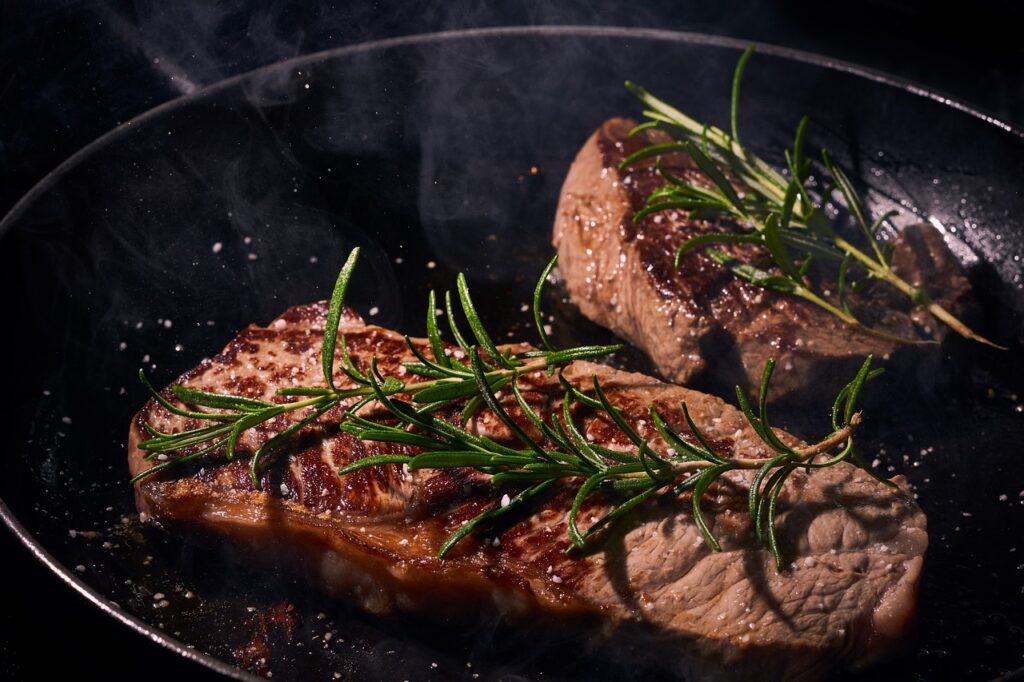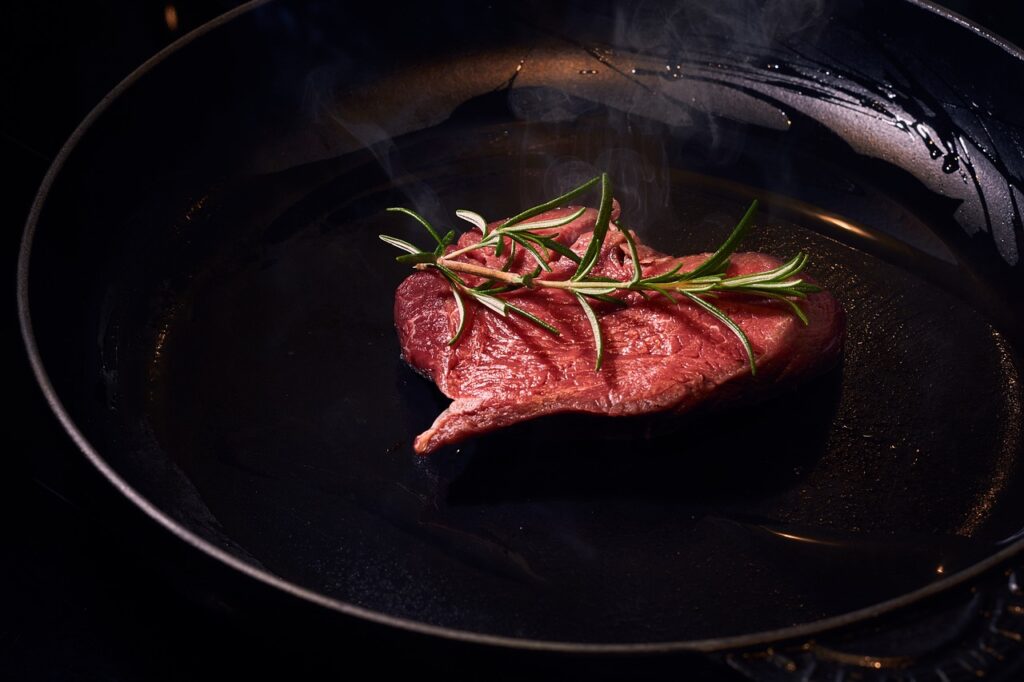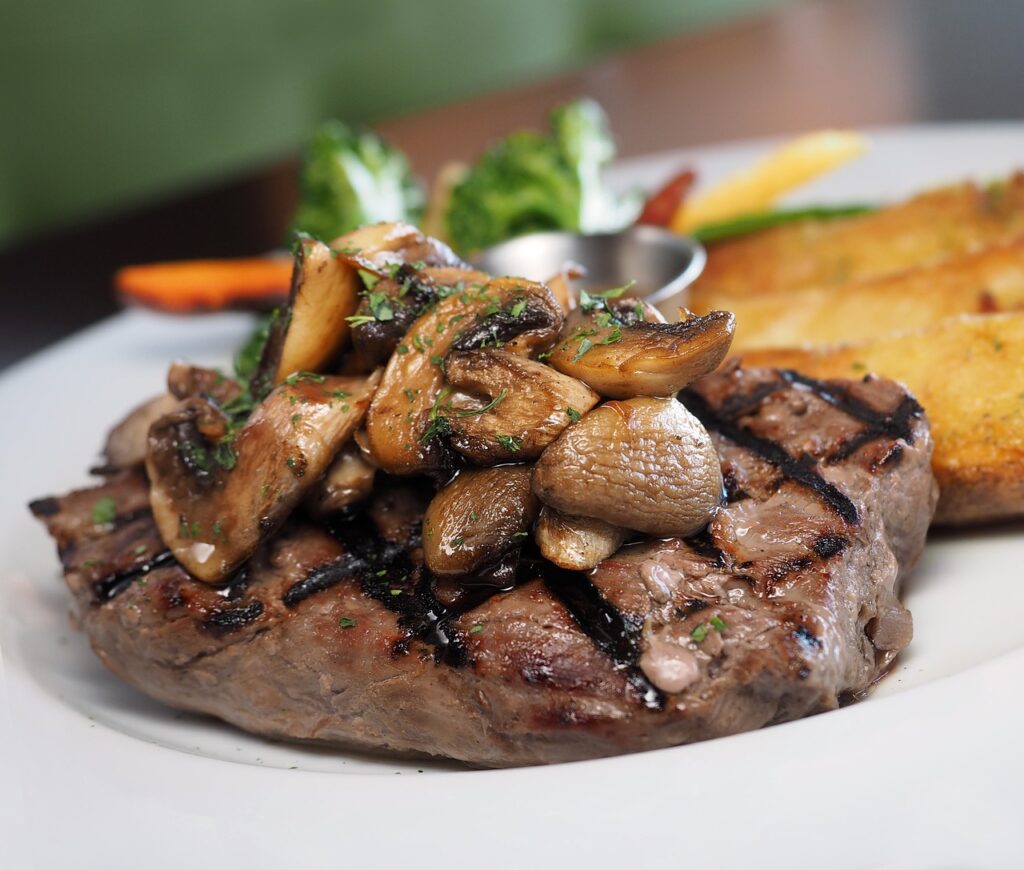When cooking your favorite cut of steak perfectly, your pan or skillet choice plays a crucial role in the outcome. With the right pan, you can achieve that desired mouthwatering sear, tender interior, and glorious flavor you’re after. But what exactly is the right pan for cooking steak?
Contents
What is The Best Pan For Steak?
Many would agree that a cast iron skillet is the best pan for cooking a steak. These heavy-based pans distribute and retain heat evenly and are perfect for searing steaks and one of the ideal cookwares for high heat cooking. I’ve got a large square one with ridges that make my steak look like it’s been flame-grilled. Unlike the others, I can say that this pan is best for cooking eggs and our weekly steak and fries night.

Cast iron pans and skillets are ideal for searing steaks. However, as much as I love using my cast iron skillet for searing steaks, I find it heavy to handle and painful to clean (especially between those ridges).
Benefits of Cast Iron Pans
While cast iron pans meet most of the criteria for searing the perfect steak, there are some more advantages to using them:
- Cast iron pans are prized for evenly distributing and retaining heat. This makes them the ideal pan to achieve the perfect sear on your steak.
- They are also versatile; they can go on the stove and in the oven. Such versatility allows various cooking techniques, such as searing or finishing in the oven.
- Cast iron pans make an excellent investment as they can last for generations if properly maintained.
- When seasoned and used correctly, cast iron pans develop a natural nonstick surface perfect for eggs and other dishes. This reduces the need for excessive oil or basting.
Cons of Cast Iron Pans
The few disadvantages of cast iron pans are listed below:
- Cast iron pans are heavy, making them challenging to handle.
- They require proper seasoning and care to retain nonstick properties and prevent rust.
- Cast iron takes longer to heat to the desired temperature than other materials.
The Basic Requirements Of The Perfect Steak Pan
Selecting the perfect steak pan shouldn’t be left to chance. Below are some fundamental factors to look for when searching for the best steak pan:

Material
The best steak pans are cast iron, stainless steel, or carbon steel. Additionally, they should have a nonstick coating or, in the case of cast iron, be seasoned.
Heat Conductivity
Excellent steak pans distribute heat evenly and efficiently and don’t have hot spots. The pan’s construction material will influence heat conductivity, so choose one of the three mentioned above. Note that cast iron isn’t a great conductor of heat, which is why it has excellent heat-retention properties.
Heat Retention
Thick cuts of steak cook better at a consistent cooking temperature. Therefore, it’s crucial to choose a pan that retains heat.
Size and Shape
Choose a pan to match the size of your steak. For example, a too-small pan will need more room to sear your steak. In contrast, a too-large pan may cook your steak unevenly.
Weight
A pan’s weight will affect its ability to retain heat and its ease of use. Usually, heavier pans retain heat better, but their weight makes them difficult to handle. (I’m not sure how much mine weighs, but it kills my wrist!)
Handle Design
Choose a skillet with a heat-resistant and comfortable handle to ensure safe and convenient cooking.

Comparison Of Pans For Cooking Steak
Using the criteria above, let’s compare the three best pans for steak:
| Comparison of Ideal Steak Pans | |||
| Material | Cast iron | Stainless steel with aluminum or copper core | Carbon steel |
| Heat Conductivity | Moderate | Moderate to good | Excellent |
| Heat Retention | Exceptional | Moderate | Excellent |
| Size and Shape | Various options available | Various options available | Various options available |
| Weight | Heavy | Moderate | Moderate |
| Handle Design | Sturdy, heat-resistant handles | Heat-resistant handle | Heat-resistant handle |
Related Questions
What Pans Aren’t Ideal For Cooking Steak?
Pans that could be better for cooking the perfect steak include nonstick, aluminum, and copper pans. Nonstick pan coatings and aluminum pans don’t heat evenly nor retain their heat well, which is why these pans are ideal for cooking omelette. While copper pans heat very well, they don’t retain their heat. Additionally, copper reacts with some acidic foods and could affect the color and flavor of your steak.
Why Is It Important To Sear Steak?
Searing steak helps to eliminate excess liquid in the meat and adds flavor through the browning process. The sizzle you hear when searing a steak is the water turning into steam, and the browning is caused when amino acids interact with sugar – called the Maillard reaction.
Can You Sear Steak In A Cast Iron Pan Over A Barbecue?
Cast iron pans are versatile enough to use on most cooking surfaces – even open fires (provided the handle won’t melt). Therefore, you can use a cast iron skillet on a barbecue to cook delectable, moist, and smoky-flavored steak. However, ensure you preheat the pan before searing your steaks.
Conclusion
The best pan for steak is a cast iron skillet, although carbon steel and stainless-steel pans are also suitable. Cast iron warms and retains heat exceptionally well, allowing steak lovers to sear the perfect steak. The main disadvantage of these pans is their weight, but with practice, you can wield your cast iron pan like a boss.
Nathaniel Lee is an avid cook, drawing on his decades of home cooking and fine dining experience. He is a contributing chef at Mashed, and his recipes and contributions have been featured in Tasting Table, Edible Arrangements, Insanely Good Recipes, and The Daily Meal.
